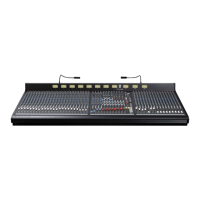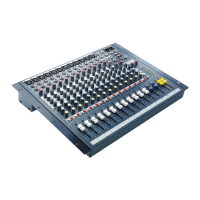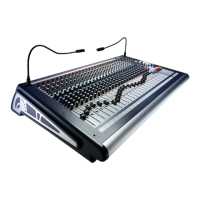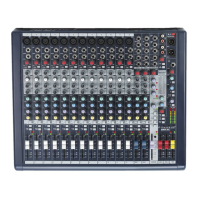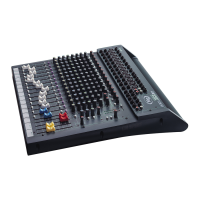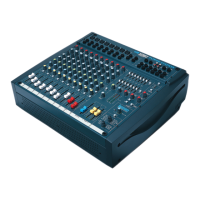Internal links are fitted which enable send pots 2 and 4 to be disconnected from their
respective PRE switches, and linked independently to the pre- or post-fade signals.
Routing
9 The PAN control determines the position of the signal within the stereo image.
In the centre position there is a 4.5dB level drop. Pan left feeds the signal to odd
numbered busses and Mix Left, pan right feeds to even numbered busses and Mix
Right.
10 The long-travel FADER has 10dB of gain and is the main level control for the
channel, enabling rapid and accurate control of the channel output level. When
mixing, you will get optimum headroom and signal-to-noise ratios by keeping the
fader at about the unity gain (0) mark. Avoid running the input sensitivity too high,
and the fader resultingly low, since this gives very little headroom. Similarly,
running the input sensitivity very low, and the fader fully up (10dB of gain) will
increase noise levels, and does not allow any increase in gain on the fader should
the source signal drop unexpectedly.
11 The ON switch enables the post EQ, post-Insert channel signal path: when
released, all post-fade Auxiliary Sends and all routing outputs are muted. We
recommend that you switch all unused channels OFF to prevent unwanted noise
being added to any parts of the mix.
12 The signal is sent to the stereo mix bus, mono bus and 4 group busses using
the MIX, MNO, 1-2 & 3-4 switches respectively, subject to the position of the
PAN control (see above).
The mono bus is fed directly from the post-fader signal.
13 The PFL switch feeds the pre-fade signal into the monitor/phones system
where it replaces the selected monitor source.
The red LED illuminates when the PFL switch is pressed, and also serves as a PEAK
(PK) indicator, monitoring the signal at the output of the Equaliser and illuminates
at 6dB before clipping.
14 The green SIG LED monitors the signal at the input amp and illuminates
when the signal exceeds -30dBu.
The post-fade signal is sent to the unbalanced DIRECT OUTPUT jack on the rear
panel.
Functional Descriptions December 1994 4.3

